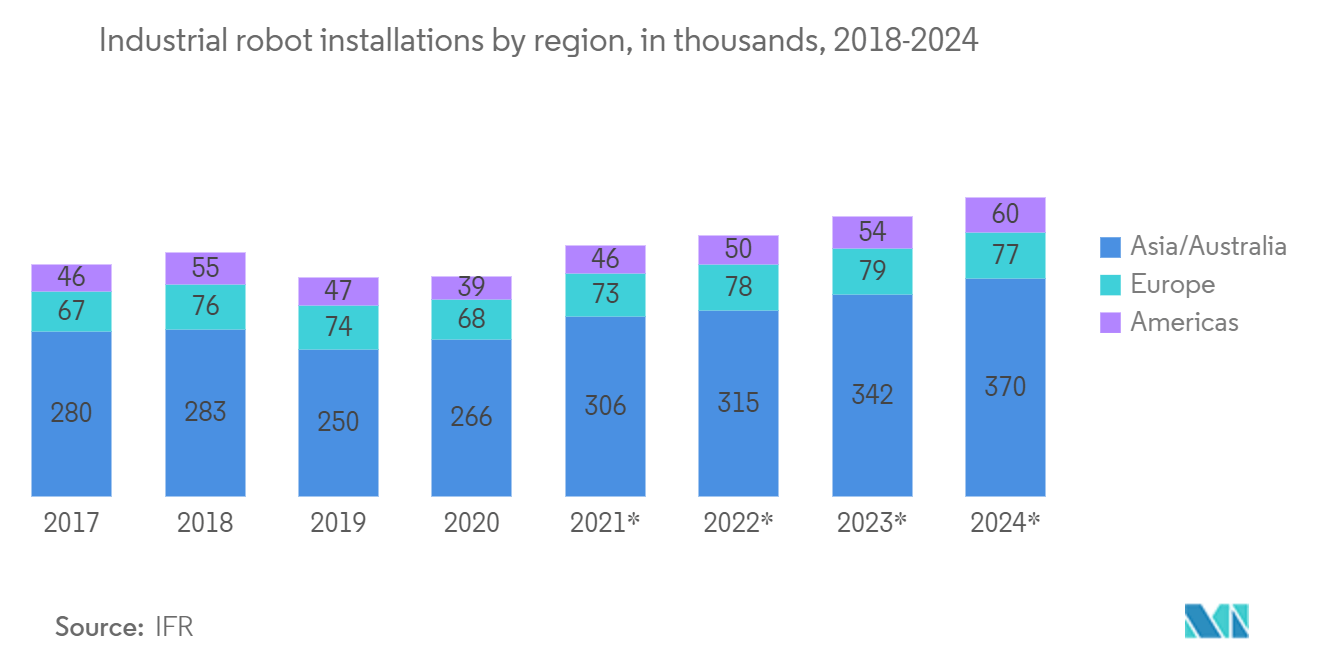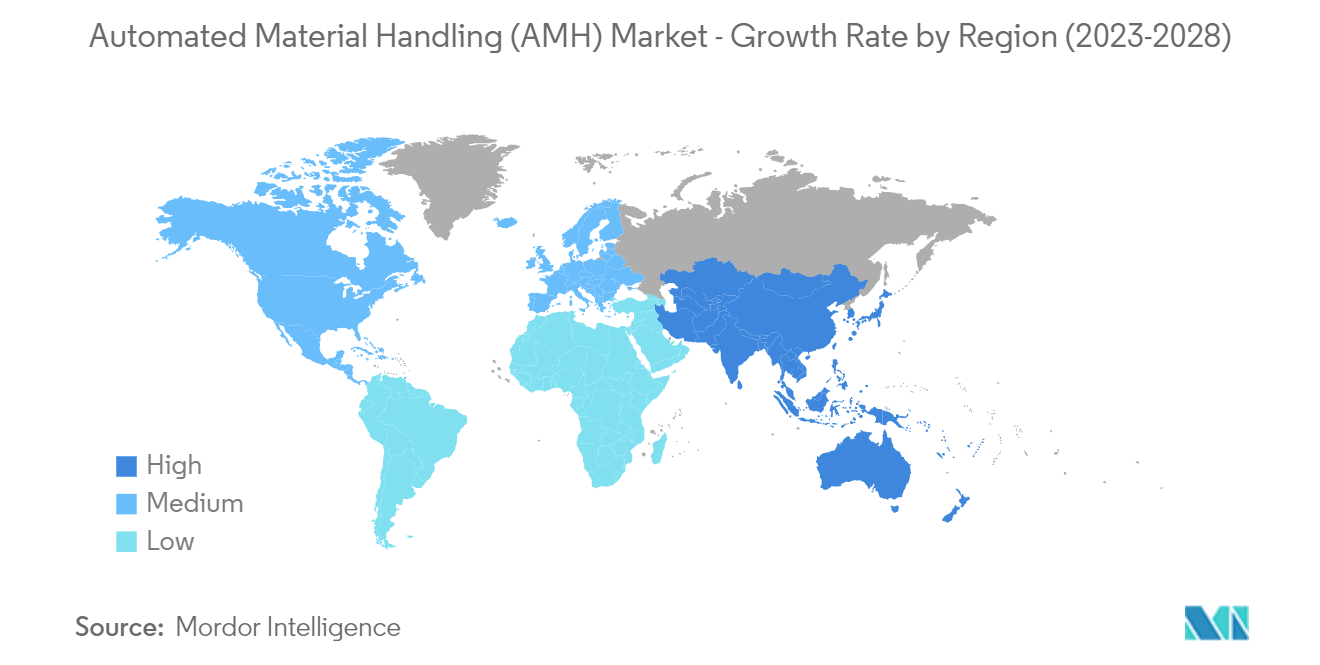Market Trends of Automated Material Handling (AMH) Industry
Industry 4.0 Investments Significantly Drive the Market Growth
- The market is driven by the developments occurring due to countries adopting Industry 4.0 and IOT technologies. Through the use of robotics, industry 4.0 is revolutionizing how material handling is done. In warehouses and distribution facilities, robotics is becoming more and more prevalent. In addition to picking and packaging orders, loading and unloading trucks, and even cleaning the warehouse floor, they can also be employed for these activities. Workplace accuracy and productivity can both be enhanced by robotics. Robots can also enable company save money by lowering the quantity of necessary manual work.
- For instance, as warehouses are huge, associates must walk considerable distances to locate SKUs and deliver orders to the packing and shipping regions. Every year, an average warehouse wastes 6.9 weeks on unnecessary walking and other movements, equating to 265 million hours of work at the cost of USD 4.3 billion. During each stage of the selection process, collaborative robots also minimize the need for extended walks between functional areas. The rise in material handling equipment orders will significantly drive the studied market.
- Moreover, robotics, automation, and technologies like additive manufacturing (3D printing) have a wide range of applications in Canadian industries such as e-commerce, automotive, agriculture, and pharmaceuticals. Canadian innovators are producing a comprehensive range of technologically complex, increased-value products for domestic and competitive global markets, sharing enhanced practices and laying the groundwork for collaborations that shape the future of advanced automation technologies.
- Moreover, Germany is also focused on the 2030 vision for Industry 4.0 in three strategic fields of action: Autonomy, Interoperability, and Sustainability. In this 2030 vision, the stakeholders of the platform Industry 4.0 presents a holistic approach to shaping the digital ecosystem. The goal is to create a framework for a future data economy that is by the demands of a social market economy, emphasizing open ecosystems, diversity, and supporting competition between all market stakeholders based on the specific situation and established strengths of the German industry base for the automation market.
- Furthermore, the government's strong support in the acquisition program has enabled China to move toward Industry 4.0. For instance, Siasun, a China-based industrial robot maker, has affiliations with the Chinese Academy of Sciences, which is further linked to the government. The country's adoption of industrial control systems by various companies is a notable trend. The advanced systems allow ease of production in factories. This also points to the gradual shift of companies from depending on manual labor to advanced technology-based systems that will enable the facility's automation.
- A significant trend impacting the market studied is the focus on smart manufacturing practices. According to the data from IBEF, the Government of India set an ambitious target of increasing manufacturing output contribution to 25% of the Gross Domestic Product (GDP) by 2025 from 16%. The Smart Advanced Manufacturing and Rapid Transformation Hub (SAMARTH) Udyog Bharat 4.0 initiative aim to enhance awareness about Industry 4.0 within the Indian manufacturing industry and enable stakeholders to address challenges related to automation material handling.

Asia-Pacific is Expected to be the Fastest Growing Market
- China has been a prominent contributor to the growth of the AMH market in the Asia-Pacific region. The increasing demand for AMH products across industries, such as manufacturing, automotive, and e-commerce, boosts the market's growth. China has a vast population and pursues an industrial policy. Measured on the PPP basis, the country became the global largest economy and the global largest exporter and trader during the current decade. The country is currently transitioning from a manufacturing and construction-led economy to a consumer-led economy.
- According to China's National Bureau of Statistics, total retail sales in China's consumer products market were around CNY 43,973.3 billion in 2022. The number of Chinese online buyers has risen rapidly from under 34 million in 2006 to over 845 million in 2022, enabling China's e-commerce business to proliferate. Hence, with growing e-commerce, the demand for material-handling equipment will likely rise in the forecasted years.
- Japan is predominantly a manufacturing nation. Its manufacturing industry contributes close to 20% to the nominal GDP, whereas it is close to 10% for other developed countries. According to the IMF, the country's manufacturing sector has achieved significant industrial productivity gains over the services sector, owing to the increased adoption of ICT. The automotive and electronics sectors are the most productive manufacturing sectors in the country.
- An increase in infrastructure investment by the government and investments from industries coupled with the 'Make in India' initiative is expected to drive AMH systems' demand. The Government of India aims to increase the manufacturing sector's share of the gross domestic product (GDP) to 25% by 2022, from 17% in 2018. Thus, manufacturers are expected to incorporate Industry 4.0 and other digital technologies to achieve this target.
- South Korea adopted the 4th Industrial Revolution. In Korea, smart factories will be one of the most important fields. By 2022, South Korea plans to construct 30,000 smart factories. The government of South Korea established a support program to help old companies become carbon-neutral smart factories. Those wishing to transform their factories in Korea into smart factories will receive USD 360,000 in financial assistance from the Korean government if they reach medium two levels. In addition, USD 180,000 will be awarded for reaching medium one levels. These Smart Factories will be fully integrated, automated systems that will be employed in manufacturing. The automated solutions will also follow automation for material handling and storage solutions, which will boost the studied market.

